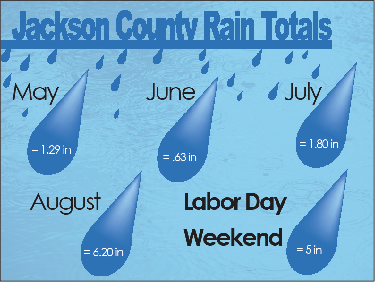Weekend rain won’t save crops

September 3, 2012
The puddles that occupied Carbondale’s streets might signify the end of the drought, but for some area farmers it’s too little too late.
Hurricane Isaac has brought a surge of rain to southern Illinois, but farmers expect little-to-no relief for their crops after this summer’s drought. Since temperatures consistently exceeded 100 degrees, corn and soybean sales are expected to take a hit, said Marc Lamczyk, a program coordinator for small farms and local foods from the University of Illinois Agriculture Extension Office of Jackson County.
Lamczyk said the heat during crop pollination was too great for it to develop successfully. When plants don’t receive enough moisture, he said, they begin to consume backup nutrients from within the stalk.
Advertisement
“When corn gets dry, it takes nutrients from itself,” Lamczyk said. “It will begin to cannibalize the stalk itself.”
Many stalks had to consume their stored nutrients and were unable to recover because of the lack of rainfall in the region, and this greatly affected the amount of bushels that will be sold, he said.
Lamczyk said a typical year yields between 100-150 bushels per acre for farmers in Jackson County. This year, many farmers expect between 19-50 bushels per acre and in some extreme cases may not yield anything.
Luckily for many farmers, crop insurance covers a large sum of losses sustained from the drought, said Dwight Sanders, a professor in the Department of Agribusiness Economics.
There are various types of plans a farmer can receive depending on need, but some can receive up to 85 percent of what they spent and some areas won’t be as affected as others, Sanders said.
Lamczyk said about 70 percent of Jackson County farmers have crop insurance. He said this is not necessarily the case for all areas of southern Illinois.
Only about 30 percent of Johnson County farmers have crop insurance to cover their losses, he said, because the county has crops grown on high ground and tend to sustain healthier growth.
Advertisement*
Although farmers will receive aid to minimize their losses, the real economic disparity will hit those who buy the crops, Sanders said. Much of the corn in this area is used to feed farm animals such as cattle, he said.
“It will have a huge impact on end users,” Sanders said. “The big hit will be on livestock producers.”
Sanders said the overall economic impact is yet to be seen.
“It’s hard to put a number on it,” he said. “It depends on the producer.”
For now, the region expects to see more rain through the rest of the week into the weekend, but most of it has passed, said southern Illinois meteorologist Larry Raymond, who created the website SIWeather.net.
Raymond said the combination of moisture and humidity that created Hurricane Isaac rose into the area and briefly caused the storms from this weekend. He said he expects the region to return to the weather more typically seen in late September to early October this year.
Despite the expected return of usual weather patterns, Raymond still thinks the drought took its toll and will continue to have a presence in southern Illinois.
“It’s not over,” he said. “We still need more rain.”
Advertisement







